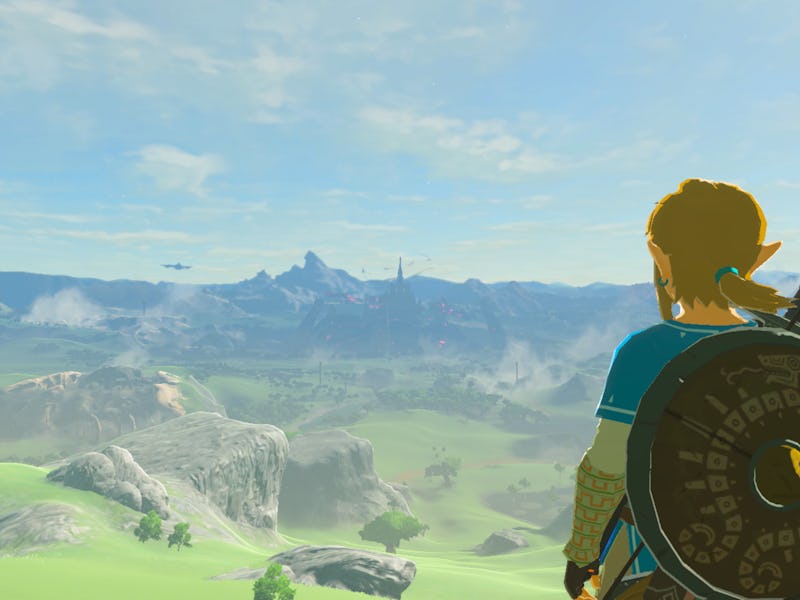'Zelda: Breath of the Wild' Shows Open World Games Need an Overhaul
Link's latest adventure reminded us how genuine an open world experience can be.

When I first awoke as Link from my 100-year slumber within the Shrine of Resurrection, I climbed out into what remains of Hyrule with a set of tattered clothing on my back and a few tree branches as weapons. The stage was set for adventure and — as I was surprised to realize — there wasn’t a checklist of tasks to complete, no tutorials to wade through, or a specific person I had to talk to in order to advance the plot. Instead, I was simply encouraged to explore and experiment with the mechanics of the game, to forge my own path into the open world at the heart of Breath of the Wild.
This introduction is a breath of fresh air compared to many so-called open world games. Even as the game progresses, it doesn’t fill up your quest log or cover your map with icons for the sake of giving you a list of things to experience. Rather than force you to head to a specific location because you need to talk to an individual or retrieve an item for a quest, Breath of the Wild draws you there with an interesting aspect, creature, or set piece you’re able to discover for yourself; it’s always something that naturally pulls you over. You don’t simply head to a specific location because you must. You head to a specific location because you want to, and that’s a feeling I haven’t experienced in an open world game in years.
Link waking up after a 100-year slumber within the Shrine of Resurrection.
A lot of great open world games carefully crafted this feeling in the past. The Elder Scrolls III: Morrowind had you create a character before dropping you into a foreign land from a boat and encouraging you to find a path for yourself. Middle-earth: Shadow of Mordor presented you with supernatural powers and threw a horde of orcs in your direction. And let’s not forget Metal Gear Solid V: The Phantom Pain, which tossed you into gigantic maps and let you tackle objectives without any specific orders to follow.
But nowadays, the idea of allowing players to discover things on their own is a bit of a lost art; most open world games are designed with accessibility in mind. When you’re building a game to appeal to a wider audience, you must lay out each step of the journey on paper like you’re connecting each individual strand of a spider web. From a story standpoint, one main quest must lead into another to push the narrative forward, with each set of side quests supporting the evolution of the world.
From a gameplay standpoint, the player will get more powerful, and so the enemies scattered about the world must also be changed to keep combat interesting, which inspires developers to let players know about the increasing difficulty by including a level for each enemy or laying out their new abilities in some sort of guide within the game. Essentially, there’s a bit of context for every evolving element within each game’s massive open world to make the player feel more comfortable. But by doing so, developers are taking away the self-discoveries which make the journey feel truly worthwhile when it reaches its end.
Geralt from 'The Witcher 3: Wild Hunt' killing one of many monsters placed in specific areas around the map for the sake of quest objectives.
But few of those issues come up in Breath of the Wild on the quest to defeat Calamity Ganon and restore order to Hyrule. Instead, you’re thrust into situations which force you to learn how the ecosystem of the game works when it comes to surviving the various dangers of the world one encounter at a time. There’s a lot of trial and error involved as a result, but Breath of the Wild uses this loop in a way which doesn’t make you feel like you’ve failed whenever you don’t successfully complete a challenge it throws at you.
Take the enemies scattered about Hryule, which don’t have visible difficulty levels above their heads or a numerical value on their health bar (until you acquire a certain item in-game). At first, you’ll be going up against basic bokoblins which are relatively easy to handle and allow you to master the basics of combat. But as you progress further into new territories outside of the starting area, you’ll discover more formidable enemies which require a whole new level of combat prowess to master. Rather than telling you these new, challenging enemies exist, Breath of the Wild requires you to encounter them firsthand and learn they’re dangerous. It doesn’t dissuade you from exploring certain parts of the map because you can’t handle them yet. Instead, you’re encouraged to go out and learn about these challenges organically.
Link fighting off a Lizalfos while roaming the Hebra Mountains in 'The Legend of Zelda: Breath of the Wild'.
This same concept carries into the objectives you’ll complete while doing quests in Breath of the Wild’s open world as well, which come across as optional apart from taking down Calamity Ganon and rescuing Princess Zelda. This means that you, should you so desire, could head straight to Hyrule Castle and face Ganon immediately if that’s the experience you wanted to have within the game. Naturally, it wouldn’t go over well, but once again, it’s the concept here that matters: You get to develop your own journey through Link’s latest adventure as you see fit, not how the developers pushed you to.
Each aspect of your journey through Breath of the Wild is one you must learn to handle yourself, and that’s honestly why Breath of the Wild is shaping up to be one of the best open world game’s we’ve seen in the last few years.